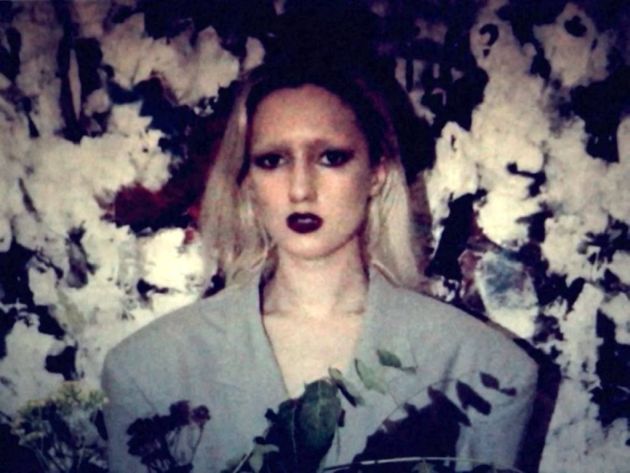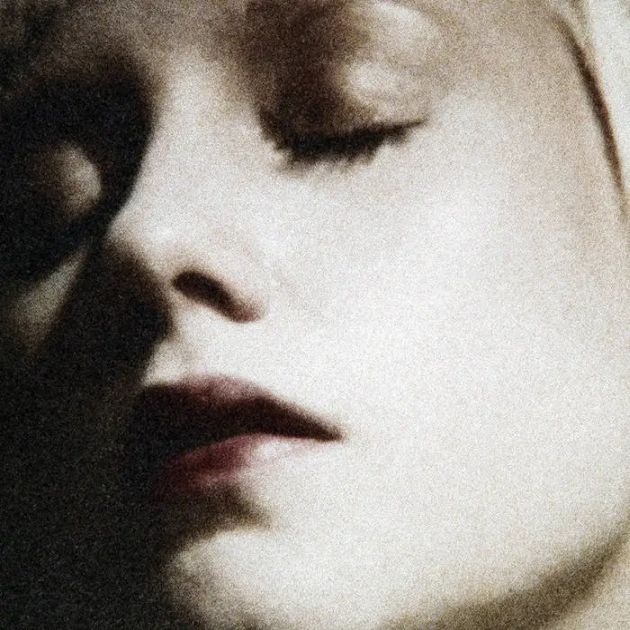 Interview with
Interview withSally Dige (music, vocals)
With ‘Holding the Sun’, SALLY DIGE steps into a new chapter of her artistic universe - one that feels at once stripped-back and incandescent. Known for her earlier work rooted in synths, nocturnal moods, and electronic precision, she now turns toward mandolin, balalaika, harp, choir and acoustic textures, building songs that feel more like living rituals than “tracks” in the traditional sense.
This album doesn’t just sound different; it moves differently. It feels painterly rather than cinematic, built on layers of texture, vulnerability, and quiet spiritual gravity. It’s a record about climbing out of darkness inch by inch, about trusting the process, and about allowing fragility to become strength.
In this conversation for Reflections of Darkness, we talk to SALLY DIGE about following intuition rather than strategy, “gibberish singing” as a doorway to truth, songwriting as a form of ritual, the decision to touch sound again through acoustic instruments, and the freedom - and weight - of running her own label in a changing Berlin.
Reflections of Darkness [RoD]: The transition from ‘Holding On’ to ‘Holding the Sun’ feels like a movement from darkness to illumination - from survival to self-possession. How conscious was that evolution? Did you plan to write yourself toward light, or did the music lead you there intuitively?
Sally: The music led me there intuitively. ‘Holding On’ was me hitting rock bottom and ‘Holding the Sun’ was me deciding that I was going to start climbing out of that hole that I was in, with hope and faith in my heart that the darkness would fade with every inch that I clawed forward. That’s why I wanted to continue the title of ‘Holding On’ to ‘Holding the Sun,’ - they are part of the same story; different chapters of the same journey. I suppose every album is a new chapter of an artist’s story, but I wanted to make it feel even more connected through the title.
RoD: Your earlier work existed in the realm of electricity - synthesizers, digital layering, nocturnal moods - and now you’ve chosen acoustic, tactile instruments. What did it change in your emotional language as a composer when you began to literally touch the sound again?
Sally: Touching the sound again made me become more vulnerable with my voice, lyrics and sound. When you are programming your sounds and running MIDI through synths, it can feel distant and detached. But when you have to pluck or strum the sounds, with all your human flaws, it opens you up.

RoD: The album title evokes an impossible gesture - ‘Holding the Sun.’ What does the Sun symbolize for you personally: warmth, power, danger, faith, or perhaps reconciliation with your own creative fire?
Sally: The sun symbolizes to me (amongst many things) a faith and trust within ourselves that even when we’re blinded by darkness or fear, each step we take will lead us in the right direction. The sun also represents this resilience and strength that we carry knowing that while all feels terrifying, dark and uncertain, we still push through and face our fears head on.
RoD: Many of your lyrics seem to move between vulnerability and strength - like soft incantations against despair. How do you approach writing lyrics that are simultaneously personal and universal, without falling into sentimentality?
Sally: My lyrics usually begin as mumble-jumbled melodies as I am jamming out the vocal melodies to the instrumental, or as Paul McCartney calls it “gibberish singing.” Somehow in this gibberish singing, the lyric skeletons start to form. Many songwriters use this process, and I find it really interesting because the words, the concerns, and ideas flow out of us naturally, like a river. I think our bodies already know what they want to say - we just have to listen. The hardest part that follows is trying to find the words that match as closely to the gibberish sound, meaning and syllables.
For example, in my song “Sow the Path,’ the original gibberish lyric was “So much that you wish for” which eventually became “Sow the path you wish for.’ I liked how the original gibberish felt to sing, and so in its cryptic form, it dictated the lyrics. I’ve also found that describing fine details helps me craft a clearer story, and makes it interesting for me as a reader too. And while singing about very personal and vulnerable experiences may make one feel naked, it is it these personal narratives that are universal. I’ve found that the more vulnerable I allowed myself to be in terms of my lyrics, the more it connected and resonated with others.
RoD: You’ve described your creative process as obsessive - rewriting, scrapping, refining. What convinces you that a song has finally reached its “truth”? Do you feel peace, or is it more a decision to let go?
Sally: As someone who is quite obsessive, I have to admit that it’s more a decision (and ultimatum) to let go. Even after releasing a song, I sometimes get stressed thinking about what I should have changed. For this reason, I try not to listen to my songs, read my lyrics or look at my work for a while after it’s been released because I seem to always find a new flaw. Before the mixing stage, I show my songs to close friends to determine if it still needs work, or if it’s done. This is especially helpful as a solo artist who spends all their time alone with their songs.

RoD: In songs like ‘Sow the Path’ and ‘Voice of My Heart,’ there’s a strong sense of spiritual and physical grounding - almost like a ritual. Do you see songwriting as a ritual act, a way to re-anchor yourself in a world that often feels dissonant?
Sally: I feel that it can be both. Songwriting opens a portal to your inner quiet self; allowing the shadow self to emerge - the voice that has been trying to reach you in dreams. That’s when the gibberish singing starts to make sense. You have the chance to sit down with yourself, as both therapist and patient and the dissonance in the waking life starts to appear in linear form. In that way it can feel ritualistic or magical - like a medium channelling a spiritual voice, except in this case the voice is our unconscious self-wanting to emerge to the forefront with the conscious body. The best thing is not to control the process but to listen and follow where your intuition leads.
RoD: The inclusion of mandolin, balalaika, harp, and choir adds a folkloric, almost sacred resonance. Was it a form of reclaiming innocence or connection - to something older, more organic - after years of working within electronic precision?
Sally: Before making ELECTRONIC music, I used to be in a traditional band and I was missing that feeling of not only playing with other musicians, but also what it felt like to pluck and strum instruments that didn’t require electricity and centre around a computer. With this album I wanted to strip back my own layers, and to connect more with my own vulnerabilities. It only made sense to then work with acoustic and organic sounds and voices which carry their own vulnerabilities, imperfections and human qualities.
RoD: You have always been a visual artist as much as a musician. How do your videos, imagery, and design evolve alongside the music? Do they extend the narrative, or are they parallel poems in another language?
Sally: I keep journals and those have been a source which I have turned to a lot for my visuals. I also try to keep my mind open: looking at the world around me, soaking in conversations, and staying sensitive to the details and messages that reveal themselves in everyday, mundane life. Often the visuals extend the song’s narrative, but other times they are their own parallel poems. There will always be a seed or thread that connects the visuals and music. Sometimes the music inspires the imagery, and sometimes it’s the other way around. For this album, many of the visual inspirations came from fairy tales, folk stories, and my own personal and ancestral narratives that I wanted to explore more deeply.
RoD: You’ve often worked independently, producing, mixing, filming - a complete artistic autonomy. What does freedom mean to you now that you’ve founded your own label? Has it made creation lighter, or heavier with responsibility?
Sally: I do work a lot independently, but I try to bring in collaborators whenever possible (and wish that I could do more collaborations). It elevates the work to bring in external talent, and I want to give credit to everyone involved. Founding my own label has been both freeing but also heavy with responsibility. There is a lightness in knowing that I control my own output and don’t have to wait for anyone’s approval or schedule. With this release, I figured since it would be a self-release, I could do whatever I wanted, and if I failed and everyone hated it - it would be on me. This eased some of the pressure of worrying about putting others at financial risk or letting them down.

I am lucky that I have a partner, Jaakko Saarilahti, who helps me run the label because it is a lot of work and we are a great team. Still, it can feel like another full-time job that I/we have taken on. Having started my own label gives me appreciation for those running labels, but also for the artist’s side too. But actually, It’s not my first label. My first band, PETROLEUM BY-PRODUCT, started our own label, Mona Mona Records when no one else would release our album, so we decided to do it ourselves. Because of this, I wasn’t totally unaware of the label and manufacturing process when I started Dige Records. I will say that I am excited when I see other bands and artists start their own label and self-releasing.
RoD: Berlin seems to play a quiet but crucial role in your work - as both a place of solitude and creative electricity. How does the city influence your artistic rhythm today, compared to the early days when you first arrived from Canada?
Sally: I don’t go to as many late-night gigs as I used to compared to my early days, for one I don’t have as much energy to be out all night long, and second, it’s just gotten too expensive. However, the city with all its unique characters and creatives continues to inspire me. Berlin definitely has been fighting its own inevitable battle against gentrification, dwindling club nights, rising inflation, and an increasingly intense political atmosphere, which has made many of my friends flee and/or close down their businesses in Germany.
Yet there are still dreamers here and I try to stay connected with these dreamers. Especially post-COVID, I feel it’s important to build community and create new realities together instead of retreating into isolation. This is something that has been inspiring me a lot lately: How to stay connected and create something together, rather than fall into isolation and personal struggle.
RoD: Your music has often been described as cinematic, but ‘Holding the Sun’ feels almost painterly - built on texture rather than plot. If this album were a painting, what would it depict? A landscape, a portrait, or perhaps pure light and shadow?
Sally: That’s an interesting question. For the music videos from the album, I was inspired by medieval and early Renaissance paintings - paintings of angel portraits, stormy seascapes and calm fields with gentle light. After spending six years with this album - living with its sounds, fears, and hopes - what have you learned about patience, and about yourself as an artist?
I have learned that it is okay to give more time to the creative process and that being slower than others in creating is not a weakness, or a bad thing. Creativity requires learning, exploring, reflection and refining, and that takes time. I also learned not to feel shame about how I release music. I had to put this album out piece by piece as singles before compiling it six years later onto one album. It was simply because I didn’t have the funds for a full album production at once, so I had to break it up into singles. But it’s better to work with your limitations in small steps, than to do nothing at all. So long as you are doing it, step by step, you will get there in the end.
Pictures Promo by Sally Dige




